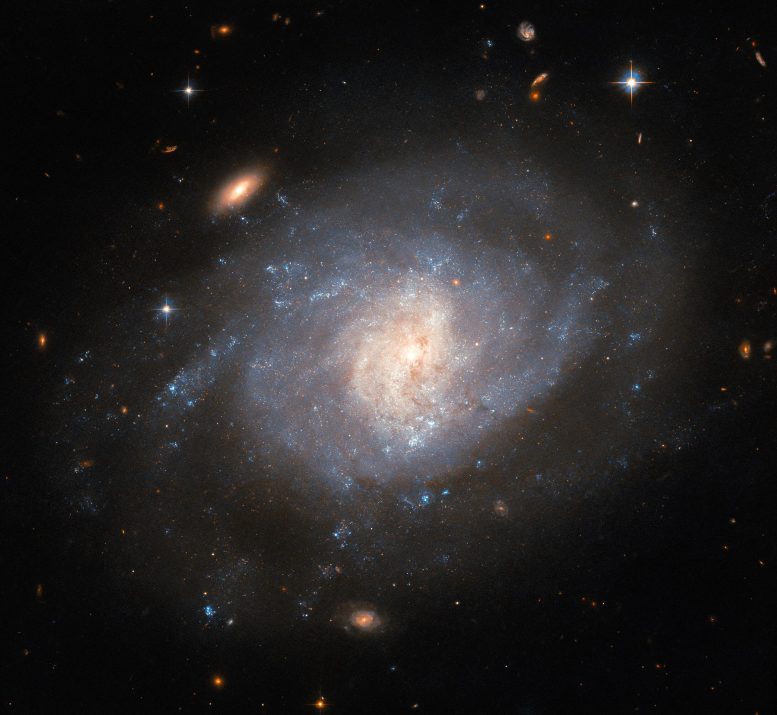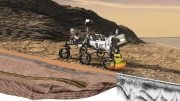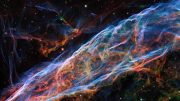
The Hubble Space Telescope captured this image of the spiral galaxy NGC 941, located 55 million light-years away, while investigating the remnants of supernova SN 2005ad, a Type II event. Credit: ESA/Hubble & NASA, C. Kilpatrick
This Hubble Space Telescope image features the spiral galaxy NGC 941, which is located approximately 55 million light-years from Earth. The data used for this image were collected by Hubble’s Advanced Camera for Surveys (ACS).
The beautiful NGC 941 is undoubtedly the main attraction in this image; however, this hazy-looking galaxy was not the motivation for the data being collected. That distinction belongs to an astronomical event that took place in the galaxy years before: the supernova SN 2005ad. The location of this faded supernova was observed as part of a study of multiple hydrogen-rich supernovae, also known as type II supernovae, in order to better understand the environments in which certain types of supernovae take place. Although the study was conducted by professional astronomers, SN 2005ad itself owes its discovery to a distinguished amateur astronomer named Kōichi Itagaki, who has discovered over 170 supernovae.
The Role of Amateur Astronomers in Discoveries
This might raise the question of how an amateur astronomer could spot something like a supernova event before professional astronomers — who have access to telescopes such as Hubble. The answer is in part that the detection of supernovae is a mixture of skill, facilities, and luck.
Most astronomical events happen over time spans that dwarf human lifetimes, but supernova explosions are extraordinarily fast, appearing very suddenly and then brightening and dimming over a period of days or weeks. Another aspect is that professional astronomers often do not spend that much time actually observing. There is a great deal of competition for time on telescopes such as Hubble, and then data from a few hours of observations might take weeks, months, or sometimes even years to process and analyze to their full potential.
Amateur astronomers can spend much more time actually observing the skies, and sometimes have extremely impressive systems of telescopes, computers, and software that they can put to use.
Collaborative Efforts in Astronomy
So many supernovae are spotted by skillful amateurs such as Itagaki that there is actually an online system set up for reporting them (the Transient Name Server). This is a big help to professional astronomers, because with supernova events time is truly of the essence. After the discovery of SN 2005ab was reported, professional astronomers were able to follow up with spectroscopic studies and confirm it as a type II supernova, which eventually led to its location being included in this study with Hubble. Such a study wouldn’t be possible without a rich library of previous supernovae, built with the keen eyes of amateur astronomers.









Salute to the great scientists of America and NASA who share their information and discoveries with the world.In Iran, we don’t have interesting sites like this site, and in Iran, most scientific sites and even games were filtered.They don’t eat at all, people have to go to foreign sites and most of them can’t go.I searched a lot until I found this interesting site.I have been in Iran for more than forty years about astronomy, astronomy, geology and other scientific fields.I am researching and studying.The article that I want to send tonight from Iran on this site is related to the effects of human life in the seas and lands of the earth a hundred million years ago, by which the humans before us built all the continents and some seas on theearth.Humans who lived on earth a hundred million years ago in the form of mammals, humans and birds.The North American continent is a bird whose left wing is northeast of Alaska, which is fragmented and separated from each other or its meteorites.The left wing of this bird was cut into pieces or the humans themselves made it this way when making the shape of this bird.The right wing of this bird is from Alaska.The foot of this bird is connected to the continent of South America.The bird is in eastern Central America and its mouth is open and there is a fish in its mouth, its eye is a sea.In eastern Central America, South America, it is the face and head of an old man whose head is slightly down and his gaze is towards the east.His face is Brazilian and there are some feathers around his face, neck and ears.Peru has feathers on its ears that are exactly feather shaped.Paraguay is a red-cheeked country.It extends from the chest to the lower abdomen, and the abdomen is near the sea of the heart.The continent of Africa is the head of a mammal that has horns, and the horn of Africa is considered to be the horn of a rhinoceros, which is located on the face and forehead of this animal in the northwest of the continent.Australia is an island that is exactly in the shape of a dinosaur.It is located east of the Philippines and Indonesia.This island of Guinea and Papua is like a dinosaur with its mouth open and facing west.May God protect you everywhere, hoping to meet Dr. Mehrdad in Tehran من این متن بالا را در ترانسلیت ترجمه کردم به فارسی بود و من به زبان لاتین به وصیله ترانسلیت فارسی را به اگلیسی تعغییر دادم اما بعضی از کلمات و انشاء جمله ها خراب شده اگر شد بعدآ دوباره انشاء آن را درست و تصیح میکنم دکتر مهرداد آقاکثیری منجم ایران و مفصر ادیان کهن جهان و شاعر و نویسنده کتب نجوم وادیان به امید دیدار خدا نگهدار